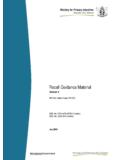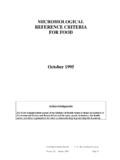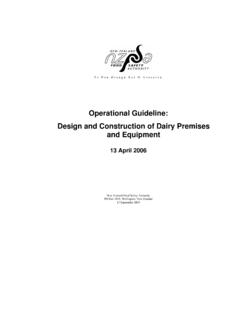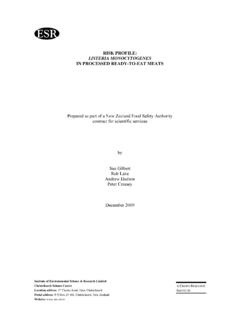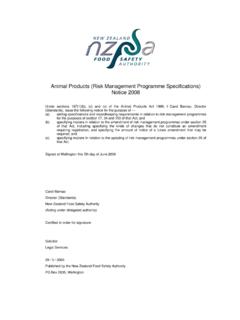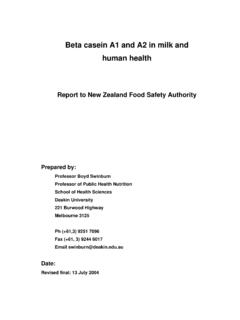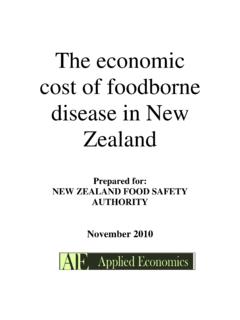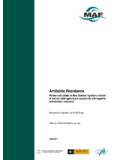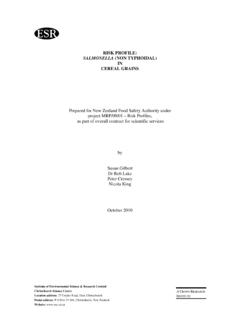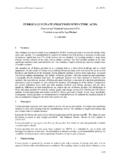Transcription of RISK PROFILE: MYCOBACTERIUM BOVIS IN MILK
1 RISK profile : MYCOBACTERIUM BOVIS IN milk Prepared as part of a New Zealand Food Safety Authority contract for scientific services by Dr Rob Lake Susan Gilbert Dr Teck Lok Wong Peter Cressey August 2009 Institute of Environmental Science & Research Limited Christchurch Science Centre Location address: 27 Creyke Road, Ilam, Christchurch Postal address: P O Box 29 181, Christchurch, New Zealand Website: A CROWN RESEARCH INSTITUTE Client Report FW08031 RISK profile : MYCOBACTERIUM BOVIS IN milk Dr Stephen On Food Safety Programme Leader Dr Rob Lake Dr Andrew Hudson Project Leader Peer Reviewer DISCLAIMER This report or document ( the Report ) is given by the Institute of Environmental Science and Research Limited ( ESR ) solely for the benefit of the New Zealand Food Safety Authority ( NZFSA )
2 , Public Health Services Providers and other Third Party Beneficiaries as defined in the Contract between ESR and the NZFSA, and is strictly subject to the conditions laid out in that Contract. Neither ESR nor any of its employees makes any warranty, express or implied, or assumes any legal liability or responsibility for use of the Report or its contents by any other person or organisation. Risk profile : MYCOBACTERIUM BOVIS in milk August 2009 ACKNOWLEDGMENTS The authors would like to thank Phil Fawcet, National Manager International Standards, Dairy and Plant Products Group of the New Zealand Food Safety Authority, as well as John van den Beuken of the New Zealand Food Safety Authority, for helpful discussions regarding pasteurisation legislation.
3 The authors wish to acknowledge the Ministry of Health as owner of the copyright and funders of the 1997 National Nutrition Survey and the 2002 National Children s Nutrition Survey and to thank them for access to food consumption information (24-hour dietary recall and qualitative food frequency questionnaire) from these surveys. We also acknowledge the assistance of Dr Nick Hancox and Dr Paul Livingstone of the Animal Health Board for checking the sections on control of tuberculosis in livestock. Risk profile : MYCOBACTERIUM BOVIS in milk August 2009 CONTENTS 1 EXECUTIVE 1 2 STATEMENT OF 3 Food/hazard combination and risk management 3 3 HAZARD IDENTIFICATION: DESCRIPTION OF HAZARD, FOOD AND 5 MYCOBACTERIUM 5 Sources of MYCOBACTERIUM 5 The Food Supply in New Zealand: 6 milk production in New 6 Imported 7 M.
4 BOVIS in 7 Inactivation of MYCOBACTERIUM BOVIS in 8 Exposure 8 The Hazard in the New Zealand Food Supply:.. 8 Food Consumption: 9 Qualitative exposure 11 Overseas 11 4 HEALTH AND OTHER REGULATORY 12 12 MYCOBACTERIUM BOVIS and 13 Dose 13 13 Clinical Outcomes Tuberculosis in New 15 5 DESCRIPTIVE ANALYSIS OF 17 Estimate of Risk for New 17 risks associated with 17 risks associated with other 17 Risk 17 6 RISK MANAGEMENT AND 19 Limitations and 19 Relevant food 19 Control of bovine tuberculosis in New 21 Economic costs of risk 22 Options for risk 23 23 7 24 APPENDIX 1: HAZARD IDENTIFICATION: DESCRIPTION OF HAZARD, FOOD AND 33 MYCOBACTERIUM 33 Growth and 33 Inactivation (CCPs and Hurdles).
5 33 The Food Supply in New Zealand: 33 APPENDIX 2: HEALTH AND OTHER REGULATORY 35 35 Adverse health effects 36 Risk profile : MYCOBACTERIUM BOVIS in milk August 2009 Contributions to outbreaks and 38 Case control 38 Risk assessments and other activity 39 Secondary 41 Risk profile : MYCOBACTERIUM BOVIS in milk August 2009 LIST OF TABLES Table 1: Number of dairy cattle and production of liquid milk for New Zealand, Table 2: Summary of milk consumption by New Zealanders based on data from the 1997 National Nutrition Survey and the 2002 National Children s Nutrition Survey ..10 Table 3: Identity of MYCOBACTERIUM isolates from tuberculosis notifications and laboratory sources in New Zealand, 1997 - Table 4: Outcome data for tuberculosis in New Zealand.
6 1997 - 2007 ..16 Table 5: Point and period prevalence for tuberculosis in cattle and deer herds in 2001 to 2007 ..21 Table 6: Number of confirmed M. BOVIS cases, rate per 100,000 and country TB status in European countries ..36 Table 7: Case reports, reviews and epidemiological reports concerning human tuberculosis cases due to M. BOVIS (1966-2005), by decade and country ..37 LIST OF FIGURES Figure 1: The four steps of the Risk Management Framework ..3 Risk profile : MYCOBACTERIUM BOVIS in milk August 2009 1 EXECUTIVE SUMMARY The purpose of a Risk profile is to provide contextual and background information relevant to a food/hazard combination so that risk managers can make decisions and, if necessary, take further action.
7 Risk Profiles include elements of a qualitative risk assessment, as well as providing information relevant to risk management. Risk profiling may result in a range of activities immediate risk management action, a decision to conduct a quantitative risk assessment, or a programme to gather more data. Risk Profiles also provide information for ranking of food safety issues. Tuberculosis (Tb) is most commonly caused by MYCOBACTERIUM tuberculosis, but a proportion of human cases are caused by MYCOBACTERIUM BOVIS . The notified incidence of tuberculosis in New Zealand in 2007 (including reactivations) was per 100,000 population. The proportion of total tuberculosis cases in recent years estimated to be caused by M.
8 BOVIS in New Zealand (1-3%) is similar to other developed countries. The dose response relationship for ingestion of M. BOVIS is unclear, but risk of infection via ingestion appears to be markedly lower than for inhalation from aerosols produced by infected animals. If it is assumed that approximately 3% of all notified cases of tuberculosis in New Zealand are caused by infection with M. BOVIS , then the current incidence of tuberculosis caused by this organism is approximately per 100,000. However there is no conclusive evidence that these infections are caused by transmission in milk . Given that pulmonary infections are at least as prevalent as extra-pulmonary infections, acquisition of infection by inhalation rather than ingestion of food appears to be important, possibly via occupational contact with infected animals.
9 Unpasteurised milk used to be a common vehicle for transmission of M. BOVIS . However, since the introduction of mandatory pasteurisation, milk has largely ceased to be a vehicle. Since 1995, two cases of M. BOVIS infection in New Zealand have reported consuming unpasteurised milk among the risk factors recorded, but in neither case was this vehicle confirmed. Pasteurisation is sufficient to control M. BOVIS in milk . There is likely to be some consumption of unpasteurised milk on New Zealand farms and from sales of milk at a few farm gates. A recent study of transmission of Campylobacter in a semi-rural community found that consumption of unpasteurised milk was not uncommon, with 20% of respondents reporting consumption of unpasteurised milk (Baker et al.)
10 , 2002). However, as a proportion of total national milk consumption this amount is likely to be very low. The majority of New Zealand dairy cattle are tested annually, and these show a very low prevalence of bovine tuberculosis, meaning that the risk from unpasteurised milk will also be low. Active risk management for M. BOVIS in milk in New Zealand includes: Cattle and deer herd monitoring and active measures to eradicate Tb from all breakdown herds; Mandatory pasteurisation of milk (with an exception for sales of up to 5 litres at the farm gate); and, Risk profile : MYCOBACTERIUM BOVIS in milk 1 August 2009 Vector control measures (especially brush-tailed possum and ferret control), which markedly reduces the incidence of M.

